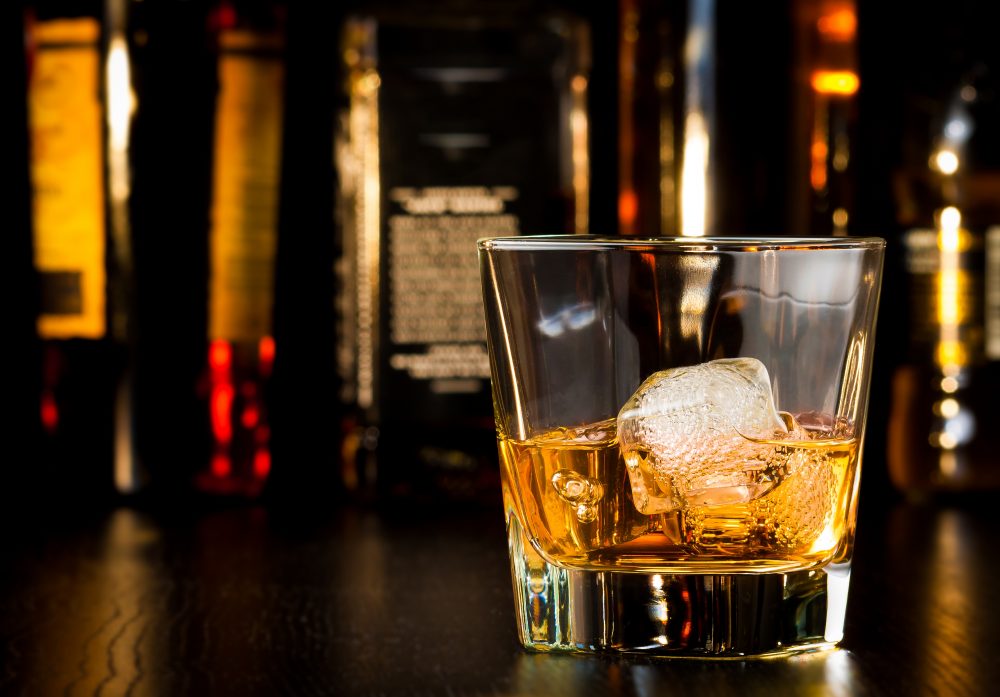Take some grain, corn, rye or wheat will do, perhaps malted barley. Ferment in a still. Age in a wooden cask, oak works well, for various years. Then put into bottles. Voila – you have whisky. Or whiskey, if you prefer.

As a general rule, it is spelled “whiskey”—with an e—in the United States and Ireland, and “whisky”—without an e—in Scotland, Japan, and Canada. An easy way to remember it is if the country has an “e” in it, so does whisk(e)y.
A simple basic process is at the root of all whiskey making, from the rotgut in the backyard still to the smoothest Irish whiskey. However, the process of refining the smooth taste has evolved over generations and has often been passed from one master blender to another. Whiskey has become strictly regulated, with very specifically defined classes and types based on both the type of grain, malt, and the aging process.
While whiskey lovers and purists maintain that whisky should be served neat, or with a splash of water or on the rocks if you must, today’s bartenders and mixologists have developed extensive cocktail recipes designed to reach new whiskey fans. If you’re not ready to handle the taste of whiskey straight, eager newcomers to this alcoholic beverage might prefer to start off with some full of other flavors that might not be as appealing to a whiskey aficionado.
History of Whiskey
The process of producing whiskey from the distillation of fermented grains has its roots in ancient Mesopotamia. Eventually, the technology reached monasteries in Europe and was then embraced in the British Isles much later in the 11th century.
We can toast the Irish trailblazers for pioneering what would become American Whiskey. They settled in the mountainous regions of Kentucky and Tennessee as these areas proved ideal for distilling because they had all the requisite ingredients – pristine water, wood for liquor barrels, and corn.
In its early days, the industry clashed with then-president George Washington. His proposal to tax the product sparked off the infamous “Whiskey Rebellion.” The tax protest lasted from 1791-94, before being quelled. The tax remained difficult to collect though, and it was subsequently scrapped in 1802. Our founding fathers liked an evening tipple.
From the onset, American whiskey was fermented primarily from rye and corn. The finished products fell into two distinct lines – bourbon and sour mash – and over the years these tastes have defined what an American whiskey is. Tennessee is probably best known for the sour mash.
Whiskey Taste Profiles
Whiskeys are generally categorized by the five main regions where they originate from, their distillation techniques, and the fermented grains. No surprises here – Scottish whisky, Irish whiskey, Canadian whisky, Japanese whisky, and American whiskey.
American Whiskey was initially created from rye as it was readily available. After that, when the distillers settled in what’s currently Kentucky, corn thrived, and bourbon whiskey was born. Whiskey brewed in the United States distinguishes itself by a characteristic sweet-savory taste, is less smoky, and has less of a peaty flavor than Irish and Scotch whiskies. American Whiskeys fall into six classes of varying taste profiles, with the main ones being bourbon, Tennessee whiskey, rye, and wheat.
Let’s take a look at the common whiskey profiles.
Bourbon – Must be made from at least 51% corn mash. Kentucky was the original home for bourbon, but it’s now made throughout the US. To be called bourbon, the whiskey must be aged in charred new oak barrels for no less than two years. Bourbon has a sweet caramel taste with vanilla undertones.
Common US Brands: Woodford Reserve, Wild Turkey, Maker’s Mark.
Tennessee Bourbon – This differs from a standard bourbon in the fermentation process. Tennessee bourbon is filtered through maple charcoal lumps to achieve a smoother and richer flavor as it ferments and ages. Made from 51-79% corn, the taste is sweeter, and slightly mellower, with sooty overtones.
Common US Brands: Jack Daniel’s (you can tour the distillery), Prichard’s, George Dickel,
Rye Whiskey – Rye whiskey should be no less than 51% distilled rye grain. The taste profile is peppery, a bit sharper and crisper than bourbon.
Common US Brands: WhistlePig Straight Rye, Bulleit Rye, Knob Creek Rye.
American Single Malt – This is one of the fastest growing American whiskey categories and is often hailed as a mash-up of American and Scottish distilling practices. It generally has a distinctive smoky flavor and a combination of both spicy and sweet.
Common US Brands – Triple Eight, Stranahan’s, Stryker.
The Best Way to Drink Whiskey
Whiskey fans consider it the water of life, something to be enjoyed at every opportunity. Here are a few ways to enjoy the drink, no matter your favorite kind of whiskey.
Neat – Most whiskey aficionados recommend enjoying whiskey neat, that is, without mixing it with water or chilling it. After the first few sips, you can choose to add a splash of water or ice cubes and enjoy how the flavors change and fuse into something new.
On the rocks – Whiskey served over ice. As you linger over the glass, the ice will dilute the whiskey and change the flavor profile. It can be more refreshing when chilled, so balance out your preferred flavors and strength to decide what works for you. If you like your whiskey chilled, but don’t want it watered down, whiskey stones are a good choice.
With a splash – A quick splash of water to mellow out a perceived harsh alcohol bite. If you don’t want to dilute the whiskey all together, you can opt for water back, meaning a separate glass of water on the side to sip as you please.
Drink specials – It seems like every bartender worth his/her salt has their own concoction. From the popular Kentucky Derby Mint Julep to a Pomegranate Sidecar (a modern twist on a classic), to Preservation Punch (a sweet berry whiskey cocktail), there’s an endless supply of creativity. Just ask at your local bar.
Celebrate World Whiskey Day
Or World Whisky Day, if you prefer.
World Whiskey Day is an annual homage to the beverage celebrated each year on the third Saturday in May. The celebration was inaugurated in 2012 by Blair Bowman and will be marking its 11th anniversary on May 21st, 2021.
It’s as good a reason as any to indulge in your favorite drink or to give it a try for the first time.
Don’t forget: Drink responsibly.



